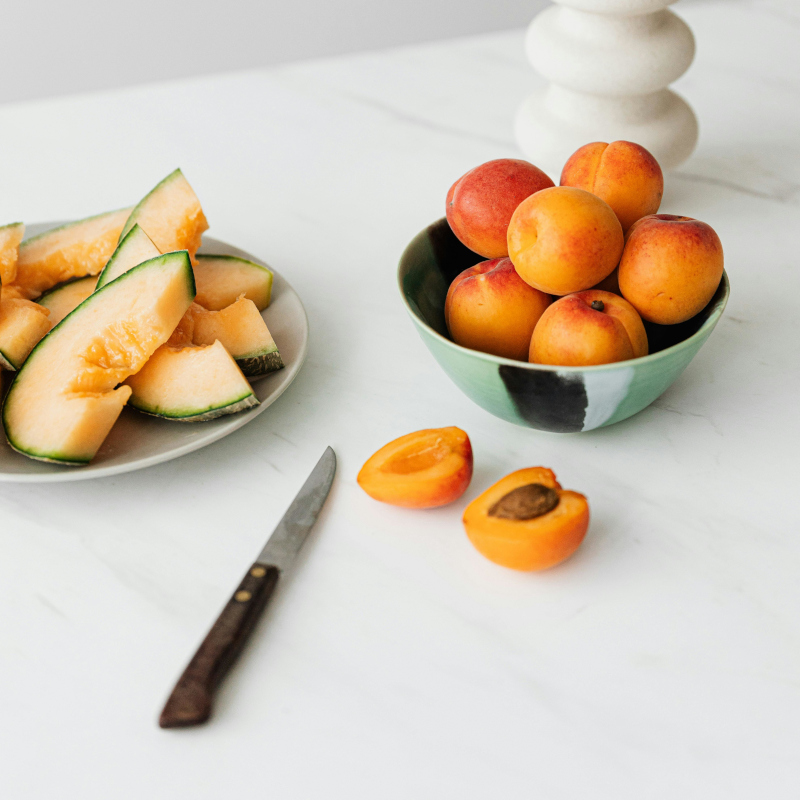fruit
/fro͞ot/
Definition. Noun.
The soft, freshy product of a tree or bush that contains seeds or a stone.
fruit
/fro͞ot/
Definition. Noun.
The soft, freshy product of a tree or bush that contains seeds or a stone.
Fruits are a key part of a healthy diet due to their high nutrient density. They provide essential vitamins and minerals, such as vitamins A and C, potassium, and folate. Fruits are also a great source of dietary fiber, which can improve digestive health. Despite their sugar content, most fruits are low in calories, as well as low in sodium and fat. In other words, whole fruit has a lot of nutrients, but few calories.

Some of the many health benefits of fruits include:
To get the most health benefits, eat a variety of fruits. Different fruits contain different types of nutrients, so eating a wide range can help ensure you get a balanced diet.
Rich in antioxidants like lycopene & anthocyanins. Promotes healthy skin & protects against some cancers.
Packed with vitamins, minerals, phytonutrients, and fiber. Helps maintain eye and heart health.
Full of antioxidants called anthocyanins. Good for anti-aging, heart health, and reduce risk of cancer.
Rich in antioxidants, vitamins, fiber, and especially carotenoids. Good for healthy skin, eyes, and heart.

Buy + Store: When buying fruit, look for fresh fruits that are free from bruises or mold. Some fruits, like apples and bananas, can be stored at room temperature, while others, like berries, should be refrigerated to keep them fresh.
Prep + Cook: Most fruits are best eaten fresh, but they can also be used in cooking. Heat can destroy some vitamins, especially vitamin C, so avoid overcooking.
How to Use: Fruits can be used in salads, smoothies, or desserts. They can also make for a great topping on yogurt or cereal.
Fruit is best bought when in season, which is when they are at their peak flavor and most nutritious. Otherwise opt for frozen fruit which is just as nutritious, as it is harvested and frozen at peak season.
Apricots
Avocados
Kiwifruit
Lemons
Limes
Pineapples
Rhubarb
Strawberries
Apricots
Avocados
Blackberries
Blueberries
Cantaloupe
Cherries
Honeydew Melon
Lemons
Limes
Mangos
Peaches
Pineapples
Plums
Raspberries
Strawberries
Tomatoes
Watermelon
Apples
Cranberries
Grapes
Kiwifruit
Lemons
Limes
Mangos
Pears
Pomegranates
Raspberries
Grapefruit
Kiwifruit
Lemons
Limes
Oranges
Pears
Pomegranates
According to the USDA MyPlate and WHO, adults should aim to eat around 2 cups of fruit per day. This can include fresh, frozen, or canned fruit. A cup is equivalent to a small apple, a large banana, or a large orange.
Also, the following counts as 1 cup fruit:
| Daily Recommendations by Age 1 | ||
|---|---|---|
| Toddlers | 12 to 23 months | ½ to 1 cup |
| Children | 2-3 yrs | 1 to 1½ cups |
| 4-8 yrs | 1 to 2 cups | |
| Girls | 9-13 yrs | 1½ to 2 cups |
| 14-18 yrs | 1½ to 2 cups | |
| Boys | 9-13 yrs | 1½ to 2 cups |
| 14-18 yrs | 2 to 2½ cups | |
| Women | 19-30 yrs | 1½ to 2 cups |
| 31-59 yrs | 1½ to 2 cups | |
| 60+ yrs | 1½ to 2 cups | |
| Men | 19-30 yrs | 2 to 2½ cups |
| 31-59 yrs | 2 to 2½ cups | |
| 60+ yrs | 2 cups | |
Step 1
Step 2
Don’t just say I’ll eat more fruit. It’s too vague. Here’s what to do:
Set a goal. If you haven’t been eating fruit regularly, start by eating one portion of fruit every day. Once you get in the habit of eating one portion daily, then level up and make it two portions per day.
Keep a food or wellness journal. Write down how much fruit you eat every day. This will keep you accountable and encourage you to eat more fruit.
Step 3
Fruit is endlessly versatile. So go beyond bananas and apples. Here’s how:
These are the main types of fruit.